

Special Article - Year 2015 - Volume 30 -
22 years of an Informational Overview Course on Plastic Surgery
Vinte e dois anos de um Curso Informativo de Cirurgia Plástica
ABSTRACT
For 22 years, a reproducible introductory overview course on plastic surgery for medical students, cosponsored by four medical schools, three universities and the regional chapter of the Brazilian Society of Plastic Surgery (SBCP), has contributed to medical education in Curitiba, a city of 2 million, and serving a metropolitan population of nearly 3 million people. This course helps medical students determine if plastic surgery is the right choice for them and provides valuable information about the specialty itself that will serve all participants as they go forward into their chosen fields, as plastic surgeons or not. This broad-ranging 47 hour course, limited to 120 students, is fully enrolled every year. Its content is weighted approximately 70% toward reconstructive plastic surgery and 30% toward aesthetic plastic surgery. Most lectures are presented by plastic surgeons who are full members of the SBCP. During its first 19 years of operation, 4.6% of the students completing the course have gone on to a general surgery residency followed by a plastic surgery residency, and are current SBCP members. The course has become a valuable educational and marketing tool for the regional chapter of the SBCP. It promotes the unique scope of the specialty and increases awareness among participants, as well as among their many personal and professional contacts (currently and in the future) about the benefits of becoming fully qualified, board-certified plastic surgeons.
Keywords: Plastic surgery; Education; Education medical; Teaching.
RESUMO
Há 22 anos, um curso informativo de cirurgia plástica para acadêmicos de medicina, promovido pela integração de quatro escolas médicas, três universidades e pela regional da Sociedade Brasileira de Cirurgia Plástica vem sendo ministrado, contribuindo para a educação médica em Curitiba, uma cidade de dois milhões de habitantes, em uma área metropolitana de aproximadamente três milhões de pessoas. Este curso informativo proporciona uma visão abrangente da especialidade, para que acadêmicos de medicina possam avaliar sua vocação pessoal para o exercício da cirurgia plástica, além de fornecer conhecimentos básicos indispensáveis à formação de qualquer médico. Anualmente o curso é ministrado em 47 horas e ofertado para 120 alunos. O programa inclui 70% de "cirurgia reconstrutiva" e 30% de "cirurgia estética", sendo a maioria dos professores membros titulares da Sociedade Brasileira de Cirurgia Plástica. Nos primeiros 19 anos de atividade (1992 a 2010), 4,6% dos alunos que concluíram o curso cursaram residência em cirurgia geral, foram admitidos na residência em cirurgia plástica e hoje fazem parte da Sociedade Brasileira de Cirurgia Plástica. O curso tornou-se um importante instrumento de educação médica, complementando o currículo de quatro escolas médicas e promovendo a cirurgia plástica como especialidade única e indivisível, enfatizando a importância da prova de especialista em cirurgia plástica e a conveniência da escolha e da indicação destes especialistas para a realização de qualquer procedimento no âmbito da cirurgia plástica.
Palavras-chave: Cirurgia plástica; Educação; Educação médica; Ensino.
Scientific and personal development is crucial in a truly comprehensive education in plastic surgery. Ancillary, complementary courses during medical school have recently been recognized as an important contributor to the eventual choice of and training in plastic surgery1.
For 22 years, a reproducible introductory overview course on plastic surgery for medical students, cosponsored by four medical schools, three universities and the Brazilian Society of Plastic Surgery (SBCP), has been used in Curitiba, a city of 2 million, and serving a metropolitan population of nearly 3 million people. This course helps medical students determine if plastic surgery is the right choice for them and provides valuable information about the specialty itself that will serve all participants as they go forward into their chosen fields, as plastic surgeons or not. The course has become a valuable education and marketing tool for the regional chapter of the SBCP. It promotes the unique scope of the specialty and increases awareness among participants, as well as among their many personal and professional contacts (currently and in the future) about the benefits of becoming fully qualified, board-certified plastic surgeons.
The medical practice and plastic surgery milieu in Brazil
Medical school in Brazil lasts 6 years, beginning immediately after high school, with 4 years of theory and practical lectures followed by a 2-year internship that includes general surgery, emergency medicine, pediatrics, internal medicine, obstetrics and family medicine.
At the end of internship, the successful student receives a medical degree and may practice medicine. Young physicians may work in any medical area but may only present and advertise themselves as a physician or general practitioner.
To advertise that one is a plastic surgeon (or practitioner of any other specialty), the physician must be board-certified in that specialty. The Brazilian General Medical Council (C.F.M.) prohibits physicians from (and often prosecutes them for) displaying a non-recognized medical specialty: Currently, aesthetic medicine and cosmetic or aesthetic surgery are not recognized medical specialties in Brazil.
Facial plastic surgery is also not a recognized specialty in Brazil2, although craniomaxillofacial surgery is considered a subspecialty and may be displayed by any plastic surgeon, head and neck surgeon, or ear, nose and throat surgeon after successful passage of that specific board certification.
Practicing plastic surgery in Brazil without displaying the specialty and without a board certification, although possible, risks possible malpractice charges and condemnation in the event of an adverse surgical outcome.
To take the SBCP examination, one must have been a general surgery resident for at least 2 years and as a plastic surgery resident for at least 3 years in one of the 83 hospitals accredited by the SBCP.
Every year, approximately 233 new residents are board-certified. The residency program and written and oral board examinations conducted by the SBCP cover such topics as burns, congenital deformities, trauma, post-cancer reconstruction and technical areas from hand and microsurgery to craniomaxillofacial surgery.
Why offer an informational overview?
In many Brazilian medical schools, the extent of information regarding plastic surgery for medical students is limited to a few lectures on burns, congenital deformities, trauma and graft and flap applications for various reconstructive procedures.
The current focus on cosmetic surgery by both mass media and physician marketing reinforces an academically and publicly distorted and even frivolous view of plastic surgery.
From 1992 to the present, the lead author has spearheaded an informational overview course on plastic surgery for medical students3, "CIPLAST" (Portuguese acronym for Informational Plastic Surgery Course).
The course was carefully designed to present and promote a more classical and realistic view of the specialty of plastic surgery, focusing on plastic surgery as the surgical specialty where reconstruction meets aesthetics and aesthetics enhances reconstruction.
Structuring the course
In collaboration with the regional chapter of SBCP, 15 full members, including professors at the 4 local medical schools and special guest professors, were invited to join the program as lecturers in a broad-based plastic surgery program (Chart 1), in Curitiba, home to 180 board-certified plastic surgeons. An attorney and six other specialists not related to cosmetic surgery are also invited as complementary lecturers (Chart 2).
The host universities collaborate by offering auditorium and media facilities, as well as official certification for the students and interns who complete the course with an attendance record of at least 75%.
Each year, for 24 weeks, once a week, in the evening from 8 to 10 pm, 120 students from 4 different medical schools get together to learn from the professional and life experiences of the lecturers as they relate to plastic surgery. Based on those encounters, many enthusiastic students request visits to lecturer-surgeons' operating rooms. The surgeons receive the students in their private clinics or hospitals, bringing awareness of their individual work, the specialty, and SBCP.
In addition to the lectures listed below, a practical one-day workshop on sutures, grafts and basic flaps using an animal model (pigs) is included4,5.
In further collaboration between medical students and lecturers, CIPLAST has also developed four teaching CD-ROMs, published in 2002, 2004, 2006, and 2008, and a book, CIPLAST- Curso Informativo Anual de Cirurgia Plástica3 (ISBN 9788591059706), published in 2010. The course costs approximately USD 80.00 per year and includes a copy of the book or CD-ROM at enrollment.
To provide continuity and to encourage further participation, at the end of each course, 3 medical students from each of the 4 medical schools are elected to an organizing committee of 12 to administer the next year's CIPLAST course. One student from among the previous year's organizers is also chosen as coordinator for the new organizing committee under the program director's supervision. Whether or not these students eventually become plastic surgeons, they are acquiring excellent experience for future participation and leadership in their specialties' societies, and for academic leadership.
RESULTS
Of 2640 medical students taking the course over its 22 years of operation (1992-2013), 2130 (80.6%) completed the course with the required 75% + rate of attendance (Figure 1).
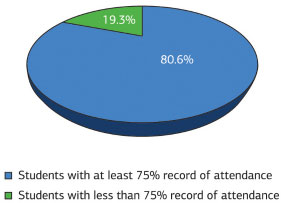
Figure 1. 2130 students (80.6%) of the total 2640 taking the course between 1992 and 2013 completed the course, with an attendance record of at least 75%.
Considering that students taking the course since 2011 would not have had enough time to have completed a plastic surgery residency (at least two years of general surgery are a prerequisite for a plastic surgery residency), 2280 students enrolled between 1992 and 2010, with 1907 (83.6%) completing the course with the required 75% attendance record (Figure 2). Among them, 88 students (4.6%) became board-certified plastic surgeons or are currently plastic surgery residents (Figure 3).
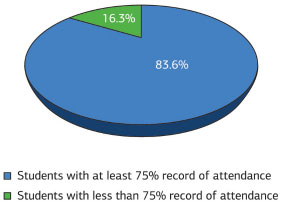
Figure 2. 1907 students (83.6%) of the total 2280 taking the course between 1992 and 2010 completed the course, with an attendance record of at least 75%.
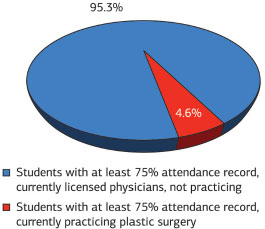
Figure 3. 88 medical students (4.6%) of the 1907 taking the course between 1992 and 2010 with 75%+ attendance record are currently board certified plastic surgeons or plastic surgery residents.
CONCLUSIONS
1. This readily reproducible course has promoted the classic, unique scope of the specialty of plastic surgery without drawing the troubling dichotomy between aesthetic plastic surgery and reconstructive plastic surgery.
2. The course has helped students determine whether their skills and interests are compatible with the future training and life-long practice of plastic surgery. The course shows the realties and exigencies of plastic surgery with its legal concerns, patient demands, and possible complications, a perspective that helps identify those who may or may not be a good match for the life and work the specialty requires. The course encourages plastic surgery-inclined students to pursue proper, traditional residency training and board certification.
3. The knowledge and skills acquired through the skin surgery workshop are a key contribution to the medical students' performance in Brazil's first aid medical stations and hospitals, where medical students are expected to suture and assist with surgical procedures, usually starting in their fourth year.
4. The course cautions against and attempts to inhibit the proliferation of non-recognized specialties and non-plastic surgeons functioning in the aesthetic/cosmetic sector. One hundred twenty students per year leave the course with the important clinical understanding and related marketing message that plastic surgery should be performed by qualified plastic surgeons.
5. The course furthers the reputation and expertise of the SBCP, the Brazilian Board of Plastic Surgery, and their certified plastic surgeons.
6. Students who do not eventually select plastic surgery as a profession leave the course with information useful to any surgical discipline and with a realistic view of plastic surgery far beyond the solely cosmetic popular perception.
7. Replication of this kind of overview course for plastic surgery or, indeed, for any specialty, can be a valuable adjunct for students attempting to select a good fit for their specialty and a valuable asset for specialty societies.
ACKNOWLEDGEMENTS
The authors wish to thank all the lecturers for their dedication and commitment to CIPLAST over the last 22 years, as well as the participating/sponsoring universities, including Universidade Positivo Medical School; Pontifícia Universidade Católica do Paraná; Faculdade Evangélica do Paraná; and Universidade Federal do Paraná; the Brazilian Society of Plastic Surgery, and the over 2000 medical students, residents, and organizers who made this program a success.
REFERENCES
1. Aguiar LFS, Méndez CKI, Gonçalves EG, Gomes FP, Gesser Cardoso FR, Nozaki GY, et al. Medical surgery leagues. Aesthetic Plast Surg. 2013;37(2):485-8. http://dx.doi.org/10.1007/s00266-012-0043-7. PMid:23344464.
2. Fernandes JW. A especialidade cirurgia plástica. In: Fernandes JW, editor. Cirurgia plástica bases e refinamentos. 2nd ed. Curitiba: Primax; 2012. p. 29-32.
3. Fernandes JW, Pereira LC. CIPLAST - Curso Informativo Anual de Cirurgia Plástica. Curitiba: JWF; 2010.
4. Purim KSM. Oficina de cirurgia cutânea. Rev Col Bras Cir. 2010;37(4):303-5. http://dx.doi.org/10.1590/S0100-69912010000400012. PMid:21085849.
5. Purim KSM, Santos LDS, Murara GT, Maluf EMCP, Fernandes JW, Skinovsky J. Avaliação de treinamento cirúrgico na graduação de medicina. Rev Col Bras Cir. 2013;40(2):152-6. http://dx.doi.org/10.1590/S0100-69912013000200012. PMid:23752643.
1. Universidade Positivo, Curitiba, PR, Brazil
2. Pontifícia Universidade Católica do Paraná (PUCPR), Curitiba, PR, Brazil
Institution: Study carried out at Universidade Positivo, Curitiba, PR, Brazil.
Corresponding author:
Julio Wilson Fernandes
Universidade Positivo
Avenida Getúlio Vargas, 2079
Curitiba, PR, Brazil Zip Code 80250-180
E-mail: cirurgiaplasticajwf@uol.com.br
Article received: January 27, 2014.
Article accepted: March 4, 2014.


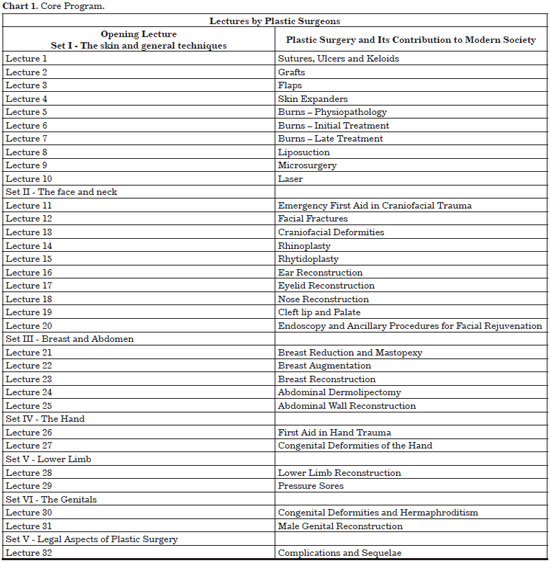
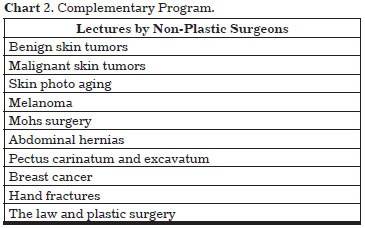
 Read in Portuguese
Read in Portuguese
 Read in English
Read in English
 PDF PT
PDF PT
 Print
Print
 Send this article by email
Send this article by email
 How to Cite
How to Cite
 Mendeley
Mendeley
 Pocket
Pocket
 Twitter
Twitter